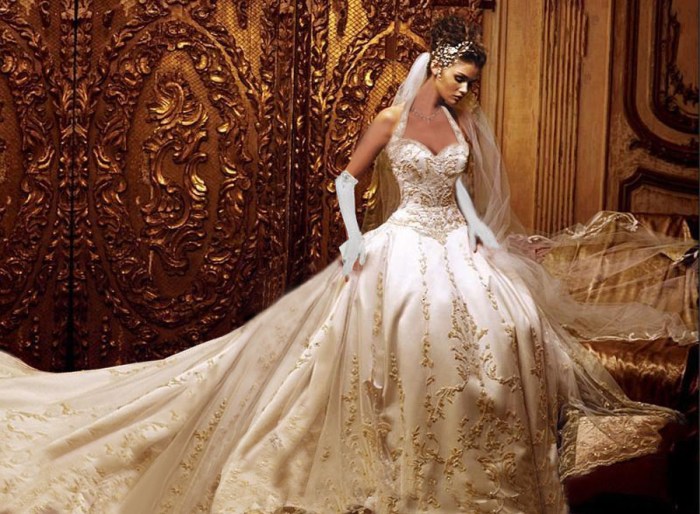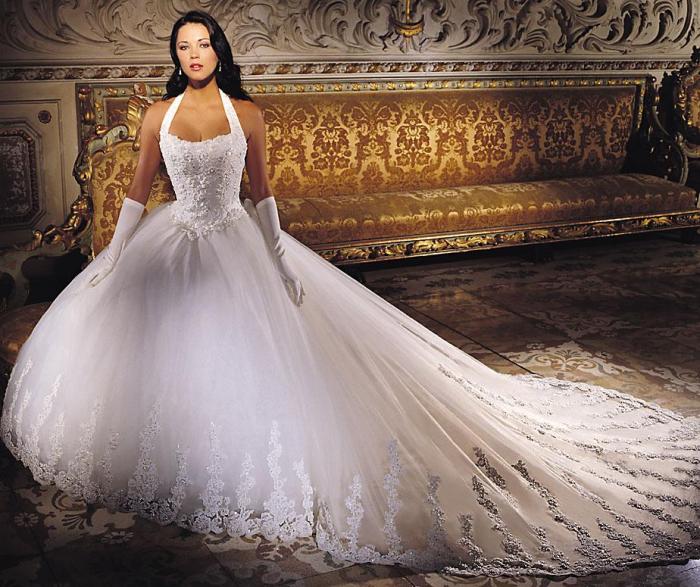Types of Wedding Dresses
Beautiful dress for wedding – Choosing the perfect wedding dress involves understanding the various styles available and how they complement different body types and wedding themes. This section explores popular dress styles, their characteristics, and historical context.
Wedding Dress Styles Compared
The table below compares popular wedding dress styles, considering their suitability for various body types and wedding themes.
| Dress Style | Body Type Suitability | Wedding Theme Suitability | Characteristics |
|---|---|---|---|
| A-line | Most body types | Casual, formal, rustic | Fitted at the bodice, gradually flaring out from the waist, versatile neckline and fabric options. |
| Ballgown | Hourglass, pear | Formal, fairytale, traditional | Full skirt, cinched waist, often features elaborate details, typically requires more space. |
| Mermaid | Hourglass, athletic | Formal, glamorous, modern | Fitted bodice and hips, flaring out at the knees, accentuates curves, can be less comfortable for extended periods. |
| Sheath | Slender, athletic | Modern, minimalist, casual | Straight silhouette, simple and elegant, often features minimal embellishments, best for those who prefer a less voluminous look. |
Historical Significance and Evolution of Wedding Dress Styles
Wedding dress styles have evolved significantly throughout history, reflecting societal trends and cultural influences. The modern A-line dress, for example, is a departure from the more restrictive styles of the past. The ballgown’s full skirt and elaborate details hark back to the romantic styles of the Victorian era. The sleek sheath dress embodies the modern minimalist aesthetic.
Fabrics and Materials

Source: streamas.si
Finding the perfect beautiful dress for a wedding is a significant undertaking. The options are vast, and considering specific styles enhances the search. For example, exploring the stunning designs available in the realm of african american wedding dresses can offer unique inspiration. Ultimately, the goal is to find that one beautiful dress that makes the bride feel radiant and confident on her special day.
The fabric chosen for a wedding dress significantly impacts its drape, texture, comfort, and overall aesthetic. This section explores common fabrics and their properties.
Common Wedding Dress Fabrics
- Silk: Luxurious, drapes beautifully, breathable but can be delicate and expensive. Examples include a flowing silk chiffon A-line dress or a structured silk charmeuse sheath gown.
- Lace: Adds intricate detail and texture, can be used as an overlay or as the primary fabric. A lace ballgown exudes romantic elegance, while a lace sheath dress offers a more modern feel.
- Tulle: Lightweight and airy, often used for full skirts and overlays. A tulle ballgown creates a whimsical, ethereal look.
- Satin: Smooth and lustrous, creates a sleek and sophisticated silhouette. A satin mermaid gown accentuates curves while a satin A-line dress provides a classic look.
- Organza: Crisp and stiff, holds its shape well, can be used for structured designs. An organza ballgown creates a dramatic, structured silhouette.
Advantages and Disadvantages of Wedding Dress Fabrics
Choosing the right fabric depends on factors such as climate, personal preference, and wedding style. Silk is luxurious but requires careful maintenance. Lace adds elegance but might not be suitable for hot climates. Heavier fabrics like satin or organza might be less comfortable in warmer weather.
Colors and Trends: Beautiful Dress For Wedding
While white remains a classic choice, non-traditional colors are increasingly popular. This section explores color palettes and current trends.
Non-Traditional Wedding Dress Colors
Shades of blush pink, champagne, ivory, and even subtle blues and greens offer a unique and sophisticated alternative to traditional white. These colors can complement different skin tones and wedding themes, creating a personalized and memorable look. For example, a blush pink A-line gown creates a romantic and soft look, while a navy blue mermaid gown exudes elegance and sophistication.
Wedding Dress Color Palettes

Source: financesonline.com
Here are some example color palettes:
- Romantic: Soft blush pink, ivory, champagne, with accents of rose gold. This evokes a dreamy, ethereal feel.
- Modern: Crisp white, silver, navy blue, with accents of metallic gold. This creates a sleek, sophisticated atmosphere.
- Rustic: Creamy ivory, sage green, dusty rose, with accents of burlap or lace. This evokes a natural, whimsical ambiance.
Current and Upcoming Trends in Wedding Dress Design
Current trends include minimalist designs, detachable skirts for versatility, and the incorporation of unique textures and embellishments. Upcoming trends suggest a move towards more sustainable fabrics and a focus on individuality and personal expression in dress design and color choices.
Accessories and Details
Accessories and embellishments can significantly transform the look of a wedding dress. This section details the impact of various accessories and details.
Common Wedding Dress Accessories and Styling, Beautiful dress for wedding
- Veils: From cathedral-length to birdcage veils, they add a touch of romance and tradition. A long veil adds drama to a simple gown, while a short veil complements a more modern style.
- Jewelry: Necklaces, earrings, and bracelets can complement the neckline and overall aesthetic. Delicate jewelry enhances a minimalist dress, while bolder pieces add drama to a more elaborate gown.
- Belts: Define the waist and add a touch of glamour. A jeweled belt elevates a simple dress, while a satin belt creates a sleek, polished look.
Embellishments: Lace, Beading, and Embroidery
Lace adds delicate texture and romance, beading creates shimmering accents, and embroidery adds intricate details. The choice of embellishment depends on the overall style and desired aesthetic. Intricate beading and embroidery might be suitable for a formal gown, while delicate lace might be better suited for a more romantic or bohemian style.
Finding the Perfect Dress
Finding the perfect wedding dress involves careful planning and consideration of personal style, budget, and shopping strategies.
A Step-by-Step Guide to Finding Your Wedding Dress
- Set a budget: Determine how much you’re willing to spend.
- Research designers and boutiques: Explore options that align with your style and budget.
- Schedule appointments: Book appointments at several boutiques to try on different styles.
- Bring supportive companions: Choose people whose opinions you trust.
- Consider alterations: Factor in the cost of alterations.
Choosing the Right Bridal Shop or Designer
Consider the designer’s style, price range, and customer reviews when selecting a bridal shop or designer. Visit multiple shops to compare styles and services.
Online vs. In-Store Wedding Dress Shopping
Online shopping offers convenience and a wider selection, but lacks the personal touch of in-store shopping. In-store shopping allows for personalized fittings and expert advice.
Budgeting and Pricing
The cost of a wedding dress varies widely depending on several factors. Understanding these factors is crucial for effective budgeting.
Price Ranges for Wedding Dresses
| Dress Type | Fabric | Designer | Price Range |
|---|---|---|---|
| A-line | Lace | Mid-range | $1,000 – $3,000 |
| Ballgown | Silk | High-end | $3,000 – $10,000+ |
| Mermaid | Satin | Mid-range | $1,500 – $4,000 |
| Sheath | Crepe | Budget-friendly | $500 – $1,500 |
Factors Influencing Wedding Dress Cost
Factors such as fabric quality, embellishments, designer reputation, and labor costs significantly impact the overall price. High-end designers and intricate details naturally command higher prices.
Strategies for Finding Affordable Wedding Dresses
Consider shopping at sample sales, consignment shops, or online retailers to find affordable options without compromising on style. Prioritizing certain aspects (e.g., fabric over embellishments) can also help manage costs.
Q&A
How far in advance should I start shopping for my wedding dress?
Ideally, begin your search 9-12 months before your wedding date to allow ample time for alterations and potential delays.
What should I wear to my wedding dress appointments?
Wear comfortable undergarments similar to what you plan to wear under your dress, and shoes with a heel height similar to your wedding shoes.
How do I know if a dress fits properly?
The dress should be comfortable and flattering, allowing for ease of movement without feeling too tight or loose. Consult a bridal consultant for professional guidance.
Can I alter a wedding dress significantly?
Significant alterations are possible, but some changes may be more difficult or costly than others. Consult with a seamstress to discuss your options.
